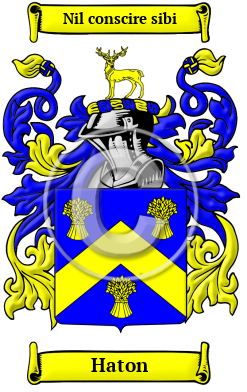| ![Show Contents]() Haton History, Family Crest & Coats of Arms Haton History, Family Crest & Coats of Arms
Etymology of HatonWhat does the name Haton mean? Haton is a name that was brought to England by the ancestors of the Haton family when they migrated to the region after the Norman Conquest in 1066. The Haton family lived in Hatton, Cheshire. Another derivation of the name suggests that it comes from the Germanic personal name Hatto, which is composed of the element hadu, which means strife or contention. 1 Although both are valid, time has confused the two definitions and historians now disagree on which is valid in any individual case. Early Origins of the Haton familyThe surname Haton was first found in Cheshire where this "noble family were descended from Sir Adam Hatton, of Hatton, county Cheshire, grandson of Wulfrid, brother of Nigel, who was lord of Halton in the same county, by gift of Hugh Lupus, Earl of Chester, soon after the Conquest." 2 Early History of the Haton familyThis web page shows only a small excerpt of our Haton research. Another 122 words (9 lines of text) covering the years 1066, 1540, 1546, 1555, 1583, 1591, 1605, 1621, 1622, 1624, 1625, 1628, 1629, 1632, 1640, 1658, 1670, 1674, 1682, 1701, 1706, 1783 and 1797 are included under the topic Early Haton History in all our PDF Extended History products and printed products wherever possible. Haton Spelling VariationsNorman surnames are characterized by a multitude of spelling variations. The frequent changes in surnames are largely due to the fact that the Old and Middle English languages lacked definite spelling rules. The introduction of Norman French to England, as well as the official court languages of Latin and French, also had pronounced influences on the spelling of surnames. Since medieval scribes and church officials recorded names as they sounded, rather than adhering to any specific spelling rules, it was common to find the same individual referred to with different spellings. The name has been spelled Hatton, Hattons, Hattyn, Hattins, Hattans and others. Early Notables of the Haton familySir Christopher Hatton KG (1540-1591), an English politician, Lord Chancellor of England and a favourite of Elizabeth I of England. "He was the second son of William Hatton of Holdenby, Northamptonshire, who died in 1546. The family was old, and claimed, though on doubtful evidence, to be of Norman lineage. Hatton was entered at St. Mary Hall, Oxford, probably about 1555, as a gentleman-commoner." 3
Sir Thomas Hatton, 1st Baronet (c.1583-1658), was an English politician, Member of Parliament for Corfe Castle (1621-1622), Malmesbury (1624-1625), and Stamford (1628-1629) and...
Another 86 words (6 lines of text) are included under the topic Early Haton Notables in all our PDF Extended History products and printed products wherever possible. Haton RankingFrance, the name Haton is the 7,391st most popular surname with an estimated 1,000 - 1,500 people with that name. 4 Migration of the Haton family to IrelandSome of the Haton family moved to Ireland, but this topic is not covered in this excerpt.
Another 70 words (5 lines of text) about their life in Ireland is included in all our PDF Extended History products and printed products wherever possible.
| Haton migration to the United States | + |
Many English families emigrated to North American colonies in order to escape the political chaos in Britain at this time. Unfortunately, many English families made the trip to the New World under extremely harsh conditions. Overcrowding on the ships caused the majority of the immigrants to arrive diseased, famished, and destitute from the long journey across the stormy Atlantic. Despite these hardships, many of the families prospered and went on to make invaluable contributions to the development of the cultures of the United States and Canada. Early North American immigration records have revealed a number of people bearing the name Haton or a variant listed above:
Haton Settlers in United States in the 19th Century- John B Haton, who landed in New York in 1841 5
| Haton migration to Canada | + |
Haton Settlers in Canada in the 17th Century- Etiennette Haton, who arrived in Montreal in 1659
The motto was originally a war cry or slogan. Mottoes first began to be shown with arms in the 14th and 15th centuries, but were not in general use until the 17th century. Thus the oldest coats of arms generally do not include a motto. Mottoes seldom form part of the grant of arms: Under most heraldic authorities, a motto is an optional component of the coat of arms, and can be added to or changed at will; many families have chosen not to display a motto.
Motto: Nil conscire sibi
Motto Translation: To have a conscience free from guilt.
- Hanks, Patricia and Flavia Hodges, A Dictionary of Surnames. Oxford: Oxford University Press, 1988. Print. (ISBN 0-19-211592-8)
- Lower, Mark Anthony, Patronymica Britannica, A Dictionary of Family Names of the United Kingdom. London: John Russel Smith, 1860. Print.
- Smith, George (ed), Dictionary of National Biography. London: Smith, Elder & Co., 1885-1900. Print
- http://www.journaldesfemmes.com/nom-de-famille/nom/
- Filby, P. William, Meyer, Mary K., Passenger and immigration lists index : a guide to published arrival records of about 500,000 passengers who came to the United States and Canada in the seventeenth, eighteenth, and nineteenth centuries. 1982-1985 Cumulated Supplements in Four Volumes Detroit, Mich. : Gale Research Co., 1985, Print (ISBN 0-8103-1795-8)
 |

